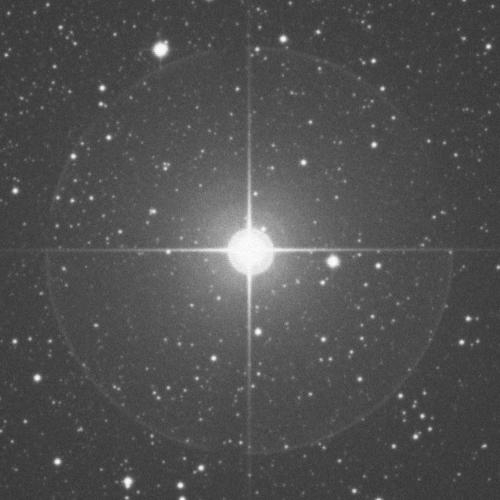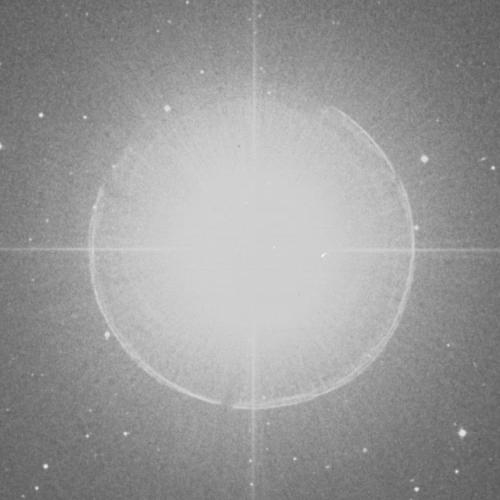
Current target list:
|type|ra |dec |repeats|note |x |y |z |gsc | |i |r |r |i |c |r |r |r |i | b 344.4121 -29.6222 220 alpha PsA A3 V 1.16 0.83732992 -0.23359611 -0.49427873 23 b 345.9429 28.0828 220 beta Peg M2 II-III 2.42 0.85584795 -0.21429303 0.47074705 23 b 165.9317 61.7508 220 alpha UMa K0 III 1.79 -0.45911129 0.11505079 0.88089735 24 b 311.5521 33.9703 220 epsilon Cyg K0 III 2.46 0.55009349 -0.62062949 0.55876309 35 b 140.5283 -55.0106 220 kappa Vel B2 IV 2.5 -0.44264884 0.36452448 -0.81925814 47 b 152.0925 11.9672 220 alpha Leo B7 V 1.35 -0.86449835 0.45787321 0.20735170 28 b 317.5833 10.1336 220 FGS 4.68 gamma Equ 0.72674206 -0.66399524 0.17594404 74
Timelines were made using the so_dev version of planquery, which uses area-definition file survey_astero to configure the S/C for ~10-minute observation segments per target per orbit.
For the week of May 17, 1999, five different targets will be observed every orbit, except for one day, where a Moon crossing will eliminate one of the targets. The five targets that will be observed, along with their approximate orbital angle, in degrees, from ascending node at the half-way point of the observation, are listed as follows:
alpha Psa 330 kappa Vel 240 alpha Leo 170 alpha UMa 120 epsilon Cyg 40For the entire day on Friday, May 21, 1999 Moon interference prevents observations of Alpha Leo.
Below is a section of a plansky orbital map, which shows five yellow
blocks (with green horizontal bands at their centers) that correspond
to observations of the five aforementioned targets. Orbit
number is monotonically increasing along the horizontal dimension of
the image from left to right. All five blocks begin at orbit number
1220. Angle from ascending node increases
monotonically along the vertical dimension from 0 degrees at the
bottom to 360 degrees at the top. The image is thus a 2-D
representation of WIRE mission time. The central block, which corresponds
to Alpha Leo, has a small missing portion where the block crosses a
Moon hole (the gap spans orbit numbers 1307-1325).
(The background colors in the image correspond to different allowed WIRE
primary-science observation types.)

There is room for one more target in the vicinity of 285 degrees from
ascending node of the orbit. A suitable target would be from within
the region on the celestial sphere with RA in the range from 330 to 360
degrees, and Dec. in the range from -75 to -80 degrees (J2000
equatorial coordinates).
Current target list:
|type|ra |dec |repeats|note |x |y |z |gsc | |i |r |r |i |c |r |r |r |i | n 344.4121 -29.6222 80 alpha PsA A3 V 1.16 (astero) 0.83732992 -0.23359611 -0.49427873 23 n 152.0925 11.9672 80 alpha Leo B7 V 1.35 (astero) -0.86449835 0.45787321 0.20735170 28 n 345.9429 28.0828 80 beta Peg M2 II-III 2.42 (astero) 0.85584795 -0.21429303 0.47074705 23 n 140.5283 -55.0106 80 kappa Vel B2 IV 2.5 (astero) -0.44264884 0.36452448 -0.81925814 47 n 165.9317 61.7508 80 alpha UMa K0 III 1.79 (astero) -0.45911129 0.11505079 0.88089735 24 n 311.5521 33.9703 80 epsilon Cyg K0 III 2.46 (astero) 0.55009349 -0.62062949 0.55876309 35
Timelines were made with the current so_tst version of planquery (6.2.27), which uses area-definition file survey_n to configure the S/C for ~40-minute observation segments per target per orbit.
For the week of May 24, 1999, four different targets will be observed; however, only for two of the targets, Alpha Leo and Beta Peg, will substantial observation data be accumulated. The remaining targets, Alpha Psa and Kappa Vel, will be observed for just a few orbits each. The four targets that will be observed, along with their approximate orbital angle, in degrees, from ascending node at the half-way point of the observation, are listed as follows:
alpha Psa 313 kappa Vel 240 alpha Leo 152 beta Peg 11
The observation of each target will take place over almost half of an entire orbit, which is a significant improvement over the observing strategy of last week. The improved observation efficiency is due to David Henderson's very recent modification of planquery to relax the ram viewing constraint. Thanks, David!
Below is a section of a plansky orbital map, which shows large yellow blocks (with green horizontal bands at their centers) that correspond to observations of the four aforementioned targets. Orbit number is monotonically increasing along the horizontal dimension of the image from left to right. Angle from ascending node increases monotonically along the vertical dimension from 0 degrees at the bottom to 360 degrees at the top. The image is thus a 2-D representation of WIRE mission time. (The background colors in the image correspond to different allowed WIRE primary-science observation types. The circular black regions are Moon holes.)
Early in the week, Alpha Leo and Alpha PsA are the two targets observed per one orbit. Throughout most of the week, Alpha Leo and Beta Peg are observed in a given orbit. Near the end of the week, Beta Peg and Kappa Vel are observed in a given orbit.
The large middle block, which corresponds to Alpha Leo, begins at orbit number 1346 (starting on May 24 just after midnight), and ends at orbit number 1426, about 5 days later. Alpha Leo is a B7 V star with magnitude 1.35.
The lower-most block, which corresponds
to Beta Peg, shows that this target will be observed continuously over
about a 3.5-day period. Small portions of its nominal observation times are
truncated in most of its orbits by
Alpha Leo observations, so that on a per-orbit-basis, the integration
time on Beta Peg will be about 10% less than for Alpha Leo.
Beta Peg is a M2 II-III star with magnitude 2.42.

Throughout this week, the only target that will be observed is Alpha Leo. It will be observed for ~40 minutes during each orbit.
The scheduling of several other targets along with Alpha Leo were attempted, but viewing constraints would not permit them. So more Alpha Leo data will be acquired this week to supplement the data take last week and the week before. Thus we will have plenty of Alpha-Leo data for studying the its oscillation modes. By Thursday morning of this week, we should determine whether or not enough Alpha-Leo data has been acquired, so that plans for viewing a different target can be made for incorporation into next week's timelines.
Timeline generation is now done once a week, on Fridays, instead of twice a week as before, in order to reduce manpower requirements. GSFC has already approved this schedule.
On Tuesday, June 1, GSFC will upload a new S/C constraint table with relaxed angle thresholds for zenith safehold transition (ZSP) when Sun and Earth violations occur. The new settings are 60 degrees for the minimum angle between the boresight (z-axis) and the Earth-Sun line, +/-20 degrees for the maximum deviation of the normal to the solar panels (y-axis) from the Earth-Sun line, and +/-100 degrees for the maximum angle between the boresight and zenith (Earth-limb viewing constraint). The new Earth-limb viewing constraint, however, is irrelevant because GSFC has turned off its checking onboard the S/C.
This new S/C constraint table is consistent with our planner
software (planquery), which already has been updated with the relaxed
values (and therefore allowed planning of observations last week that had "Sun
violations"!).
Current target list:
|type|ra |dec |repeats|note |x |y |z |gsc | |i |r |r |i |c |r |r |r |i | n 125.6284 -59.509591 130 NSV 4058 K3III+ 1.86 (astero) -0.2955709 0.4124156 -0.8617141 23 n 165.9317 61.7508 130 alpha UMa K0 III 1.79 (astero) -0.45911129 0.11505079 0.88089735 24 n 344.4121 -29.6222 130 alpha PsA A3 V 1.16 (astero) 0.83732992 -0.23359611 -0.49427873 23 n 345.9429 28.0828 130 beta Peg M2 II-III 2.42 (astero) 0.85584795 -0.21429303 0.47074705 23 n 140.5283 -55.0106 130 kappa Vel B2 IV 2.5 (astero) -0.44264884 0.36452448 -0.81925814 47 n 311.5521 33.9703 130 epsilon Cyg K0 III 2.46 (astero) 0.55009349 -0.62062949 0.55876309 35 n 152.0925 11.9672 130 alpha Leo B7 V 1.35 (astero) -0.86449835 0.45787321 0.20735170 28
Only two asteroseismology targets, Alpha UMa and NSV 4058, will be observed during every orbit this week (the nominal integration time is ~40 minutes per orbit per target). Alpha UMa is a K0 III star with a visible magnitude of 1.79 and located at (RA, Dec) = (165.9317 degrees, 61.7508 degrees). NSV 4058 is a K3 III variable star with a visible magnitude of 1.86 and located at (RA, Dec) = (125.6284 degrees, -59.509591 degrees). The Alpha-UMa observations are truncated to a ~32-minute integration time, owing to a small overlap with the NSV-4058 observations.
In fact, these are the only targets in the above list that can be scheduled after moving Alpha Leo to the bottom of the list (since it is assumed that enough data for Alpha Leo has already been acquired; there's no way to tell right now because that data have not been processed due to a backlog caused by downtime reserved for backups).
Below is a section of a plansky orbital map, which shows two merged yellow
blocks (each with a green horizontal band at their center) that correspond
to observations of the two aforementioned targets. Orbit
number is monotonically increasing along the horizontal dimension of
the image from left to right. Both blocks begin at orbit number
1548 and end at orbit number 1660, which covers the week of interest.
Angle from ascending node increases
monotonically along the vertical dimension from 0 degrees at the
bottom to 360 degrees at the top. The image is thus a 2-D
representation of WIRE mission time. The lower block centered at 101 degrees
corresponds to Alpha UMa, and the upper block centered at 232 degrees
corresponds to KSV 4058.
(The background colors in the image correspond to different allowed WIRE
primary-science observation types.)

During every orbit this week, the same two asteroseismology targets, Alpha UMa and NSV 4058, will be observed as last week (the nominal integration time is ~40 minutes per orbit per target). Alpha UMa is a K0 III star with a visible magnitude of 1.79 and located at (RA, Dec) = (165.9317 degrees, 61.7508 degrees). NSV 4058 is a K3 III variable star with a visible magnitude of 1.86 and located at (RA, Dec) = (125.6284 degrees, -59.509591 degrees). The Alpha-UMa observations are truncated to a ~32-minute integration time, owing to a small overlap with the NSV-4058 observations.
A special set of timelines (I99168REGOTL.0) was delivered mid-week,
which is identical to the set delivered earlier for this week's observing,
except that two near-zenith observations on Saturday
night were added (area IDs 261691 and 261692). GSFC will transition the
spacecraft to ZSP during one of these observations when "parking" the
spacecraft for the weekend. Because the observation during ZSP
transition will be near zenith, a Sun-violation and consequent SCS
safeholding after a 20-second time delay will not occur as did last
week, because the viewing-constraint table for ZSP is currently not as
relaxed as for science-pointing operations. Next week GSFC will
upload a relaxed ZSP constraint table to the spacecraft that is the
same as the science-pointing constraint table. So by the following
Saturday, special near-zenith observations will no
longer be necessary.
Current target list:
|type|ra |dec |repeats|note |x |y |z |gsc | |i |r |r |i |c |r |r |r |i | n 140.5283 -55.0106 130 kappa Vel B2 IV 2.5 (astero) -0.44264884 0.36452448 -0.81925814 47 n 191.9302 -59.6887 130 beta Cru B0.5IV 1.20 (astero) -0.4937959 -0.1043308 -0.8632964 27 n 165.9317 61.7508 130 alpha UMa K0 III 1.79 (astero) -0.45911129 0.11505079 0.88089735 24 n 193.5073 55.9598 130 epsilon UMa A0p 1.77 (astero) -0.5442905 -0.1307456 0.8286455 34
The new targets for this week are Beta Cru and Epsilon UMa. Beta Cru (HD 111123) is a B0.5IV star with a visible magnitude of 1.20; it is also a variable star of beta Cep type. It is located at (RA, Dec) = (191.9302 degrees, -59.6887 degrees). Epsilon UMa (HD 112185) is a A0p star with a visible magnitude of 1.77; it is also a variable star of Alpha2 CVn type. It is located at (RA, Dec) = (193.5073 degrees, 55.9598 degrees).
Here are images of the new targets from Aladin:

|

|
| Beta Cru | Epsilon UMa |
The only other target that is sure to be observed this week is Alpha UMa, which was also observed last week.
Observations of Kappa Vel, a southern-hemisphere target, are also included in the timelines for early this week. We'll get these observations only if the timelines are uploaded earlier than usual, which is unlikely.
Below is a section of a plansky orbital map, which shows four merged yellow
blocks (each with a green horizontal band at their center) that correspond
this week's observations of the four aforementioned targets. Orbit
number is monotonically increasing along the horizontal dimension of
the image from left to right.
Angle from ascending node increases
monotonically along the vertical dimension from 0 degrees at the
bottom to 360 degrees at the top. The image is thus a 2-D
representation of WIRE mission time. The upper two blocks, from left
to right, correspond to Kappa Vel and Beta Cru. The lower two blocks,
from left to right, correspond to Alpha UMa and Epsilon UMa.
(The background colors in the image correspond to different allowed WIRE
primary-science observation types.)

During every orbit covering this time period, including over the holiday weekend, the same two asteroseismology targets, Beta Cru and Epsilon UMa, will be observed as last week (the nominal integration time is ~40 minutes per orbit per target).
Beta Cru (HD 111123) is a B0.5IV star with a visible magnitude of 1.20; it is also a variable star of beta Cep type. It is located at (RA, Dec) = (191.9302 degrees, -59.6887 degrees). Epsilon UMa (HD 112185) is a A0p star with a visible magnitude of 1.77; it is also a variable star of Alpha2 CVn type. It is located at (RA, Dec) = (193.5073 degrees, 55.9598 degrees).
The Epsilon-UMa
observations are truncated to a ~29-minute integration time, owing to
overlap with the adjacent Beta-Cru observations.
During every orbit covering this time period, Alpha Cen and Epsilon UMa will be observed (the nominal integration time is ~40 minutes per orbit per target).
Alpha Cen (HD 128620 J) is a G+ star with a visible magnitude of -0.1; it is also a double star system, with a relatively large proper motion (~4 arcseconds/year). It is located at (RA, Dec) = (219.9008 degrees, -60.8356 degrees). Epsilon UMa (HD 112185) is a A0p star with a visible magnitude of 1.77; it is also a variable star of Alpha2 CVn type. It is located at (RA, Dec) = (193.5073 degrees, 55.9598 degrees).
Below is a plansky orbital map showing how observations of these
targets are layed out. The upper block corresponds to Alpha Cen, and
the lower block corresponds to Epsilon-UMa.
The Epsilon-UMa
observations are truncated to a ~29-minute integration time, owing to
overlap with the adjacent Alpha-Cen observations.

Last revised: July 7, 1999
Software Developer: Russ Laher
Webpage by: Russ Laher
URL: http://spider.ipac.caltech.edu/staff/laher/seismology/seismologyindex.html